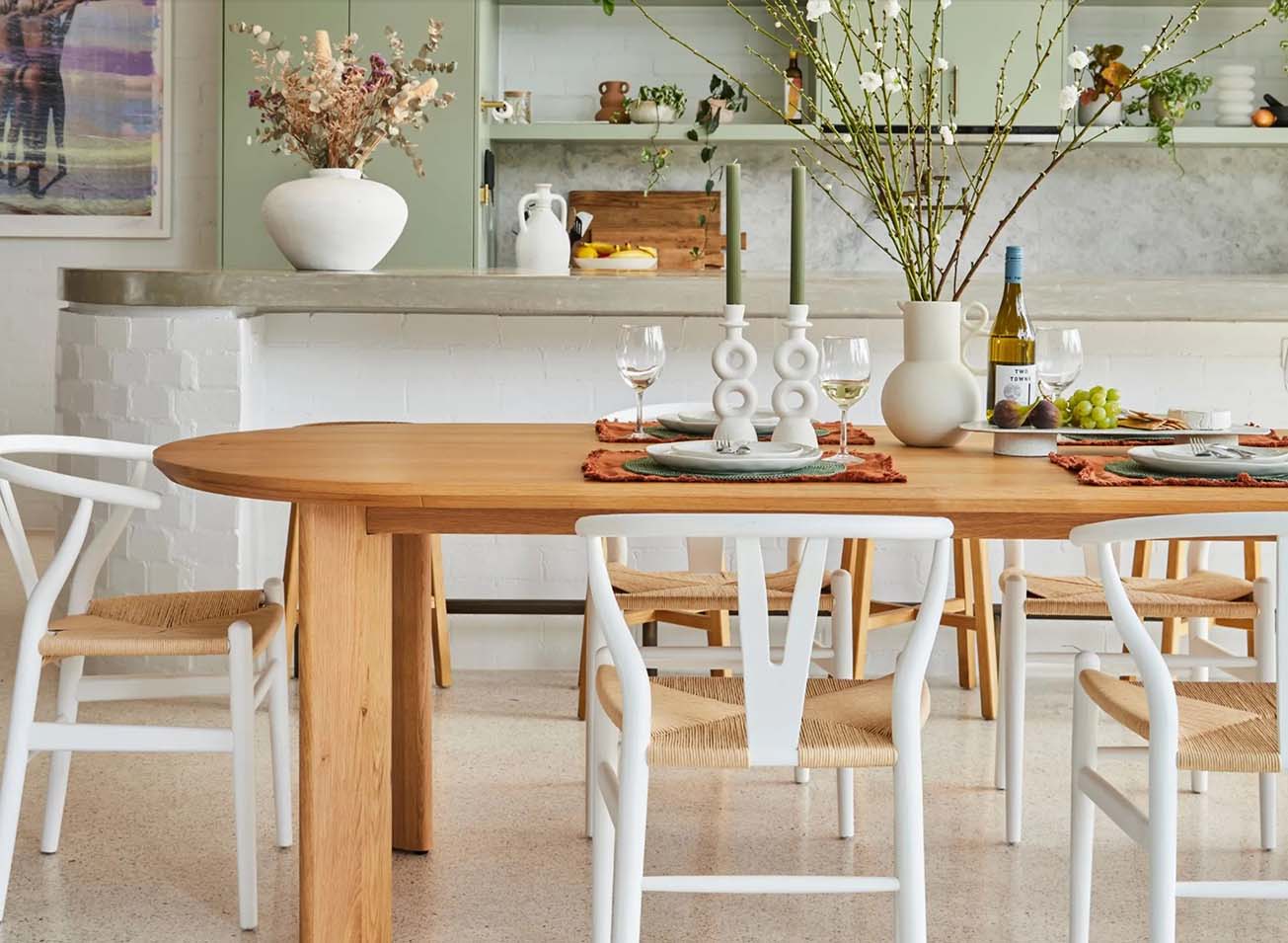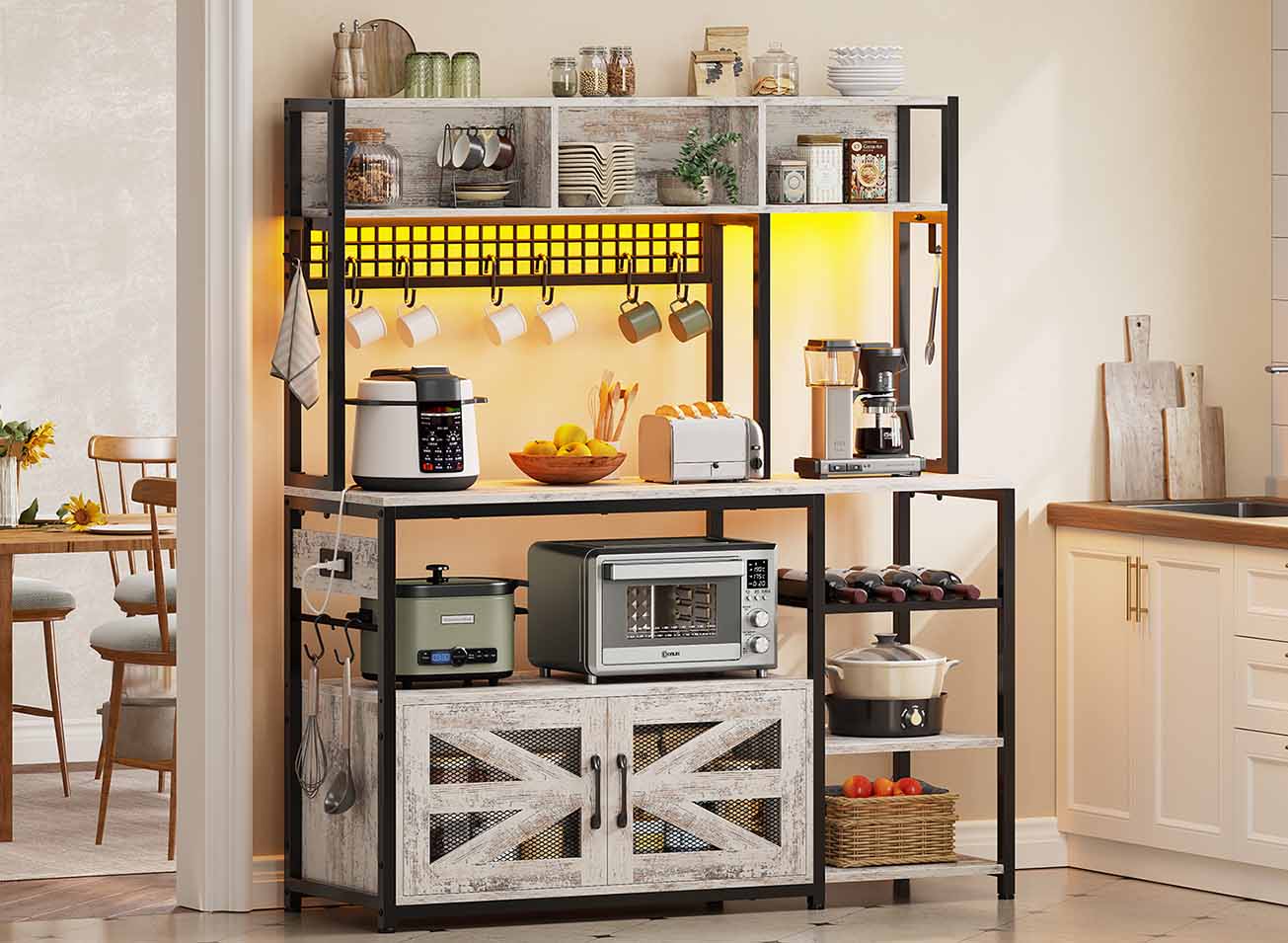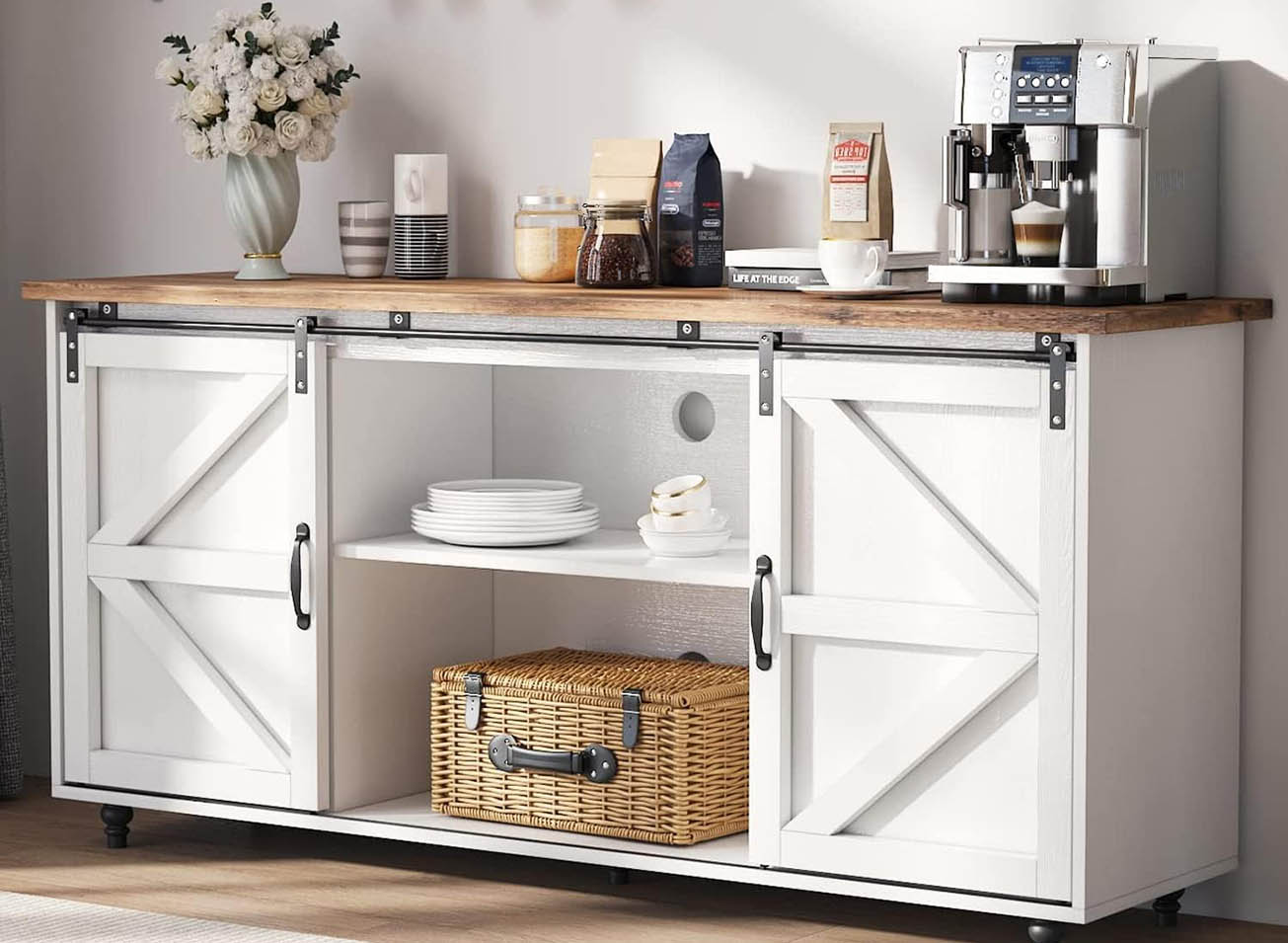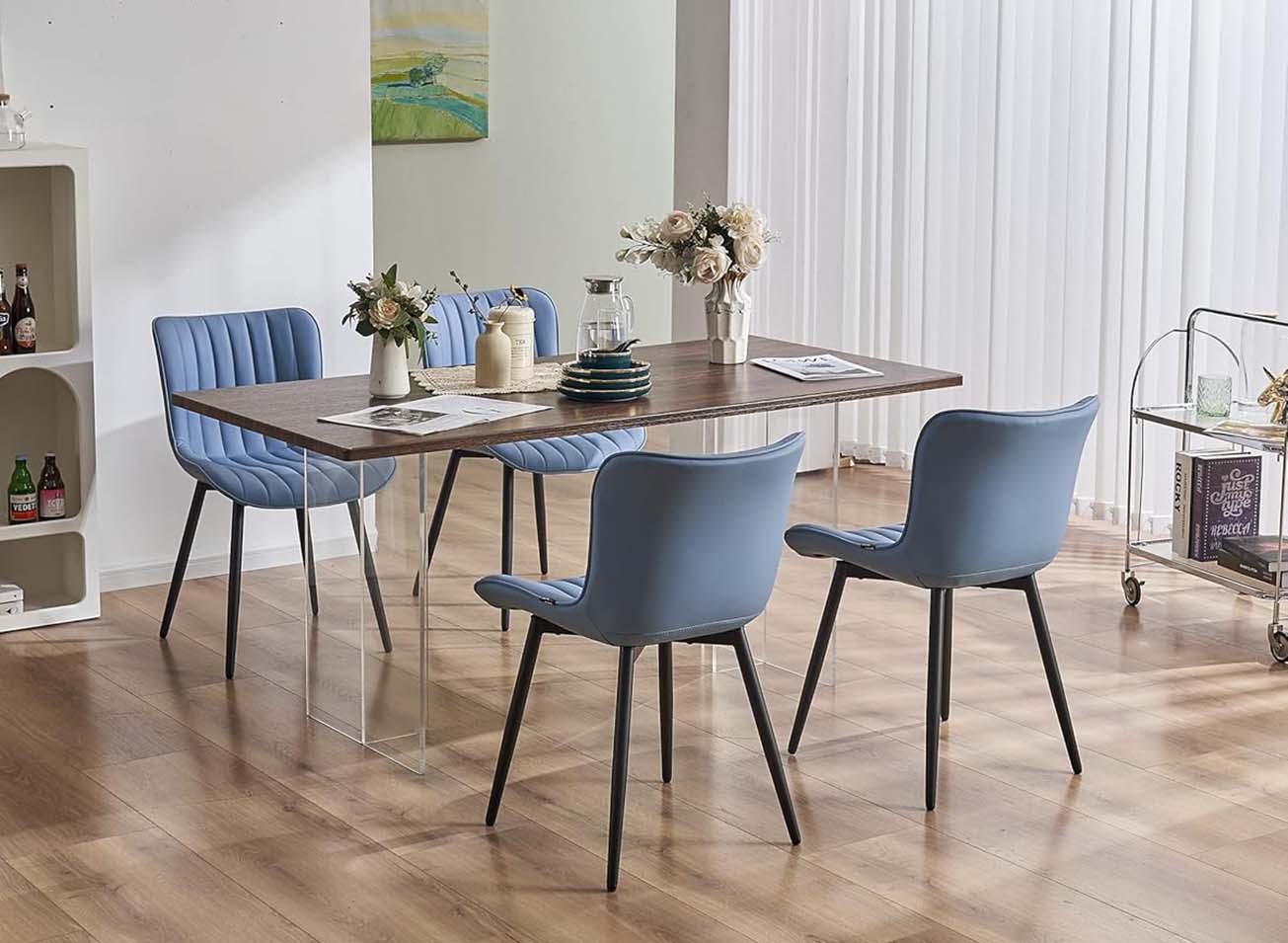In modern family life, the dining table is not just a place for meals; it also serves as a spot for family conversations, social gatherings, and even work or study. An ideal dining table design should not only meet basic functional needs but also blend with the overall décor style of the home, reflecting the owner’s personal taste and lifestyle. Thus, choosing a dining table that is both practical and stylish is crucial.
1. Functionality and Practicality of Dining Tables
1.1 The Importance of Dining Table Size
The size of the dining table is crucial for the efficiency of the dining space and the comfort of dining. The right size ensures that the table neither takes up too much space nor provides inadequate space for each person.
- Two-Person Table: Typically 60-80 cm wide and 70-90 cm long. This compact table is suitable for breakfast or in small spaces and is perfect for couples or singles. These tables often have a more refined and compact design, suitable for small apartments or kitchen corners.
- Four-Person Table: Generally 80-100 cm wide and 120-150 cm long. This size is ideal for small families, providing comfortable dining space for four people. It is suitable for most family dining rooms, offering enough space for daily meals without being too large.
- Six-Person Table: Approximately 100-120 cm wide and 150-180 cm long. This table is perfect for medium-sized families or those who frequently host gatherings. Six-person tables often come with extension features to adjust the size as needed, suitable for various occasions.
- Eight-Person Table: Usually 120-150 cm wide and 180-240 cm long. This size is suitable for large families or those who frequently entertain guests. These tables often have more complex designs and structures to accommodate more seats, ideal for spacious dining rooms.
1.2 Material Choices
The material of the dining table directly affects its durability, aesthetics, and ease of maintenance. Here are common materials and their characteristics:
- Solid Wood: Such as oak, walnut, cherry wood, etc. Solid wood dining tables are favored for their natural grain and durability. Different types of wood display various colors and grains, adding a natural beauty to the dining room. Regular application of wood wax is necessary to maintain the wood’s shine and durability.
- Glass: Such as tempered glass. Glass dining tables have a modern feel, suitable for contemporary and minimalist home environments. The transparent effect can make the space look more spacious. Glass surfaces are easy to clean but need to be protected from scratches and impacts.
- Marble: High-end and durable, suitable for luxurious and elegant home environments. Marble dining tables have unique natural patterns that add a touch of luxury to the dining room. Avoid contact with acidic substances to prevent surface corrosion.
- Metal: Such as stainless steel and aluminum alloy. Metal dining tables offer a modern feel and stable structure, ideal for industrial or contemporary styles. Metal surfaces are durable and easy to clean but may feel cold and hard, so additional accessories and decorations might be needed to enhance comfort.
- Composite Board: Such as Medium-Density Fiberboard (MDF) and plywood. Composite board tables are affordable and suitable for budget-conscious consumers. Their surfaces can be treated with various finishes, making them versatile for different home styles.
1.3 Shape Selection
The shape of the dining table affects the layout of the dining room and the dining experience. Choosing the right shape can make the dining room space more efficient:
- Round: Round dining tables are suitable for small dining rooms, accommodating multiple seats without taking up too much space. The rounded design avoids sharp edges, minimizing collisions during meals, and is great for family gatherings and social events.
- Square: Square dining tables are suitable for medium to small spaces, with a simple symmetrical shape that complements various décor styles. Square tables are easy to arrange seating and utilize space efficiently.
- Rectangular: Rectangular dining tables are ideal for large dining rooms, providing more seating. They fit well in long dining spaces and offer more dining area, making them suitable for family gatherings and entertaining guests.
- Custom Shapes: Such as octagonal or oval. Custom-shaped tables break the monotony of traditional shapes, adding unique style to the dining room. These tables are suitable for consumers seeking personalized designs and can be chosen based on the specific layout of the dining room.
2. Style and Design
2.1 Classic Design vs. Modern Style
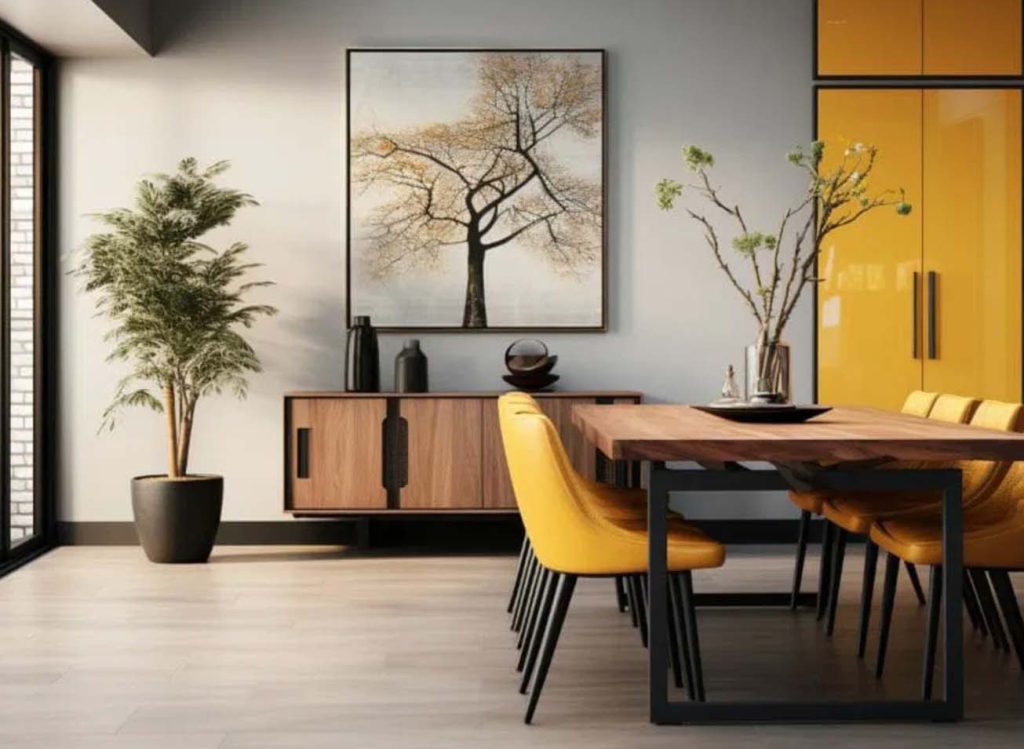
The design style of a dining table determines its overall impact on the space. Choosing the right design according to personal preference and home style can make the dining room more harmonious:
- Classic Style: Classic designs are characterized by intricate carvings and high-quality materials, including Victorian and traditional styles. These designs emphasize detail and craftsmanship, suitable for traditional and elegant home environments. Classic dining tables often use solid wood and may feature elaborate carvings and decorations.
- Modern Style: Modern dining tables usually feature minimalist, clean lines and functionality, suitable for contemporary homes. The design balances practicality and aesthetics, with materials such as glass, metal, and composite boards. Modern tables often have simple shapes and streamlined designs, adding a fresh atmosphere to the home.
- Country Style: Country-style dining tables emphasize natural, rustic wood and cozy designs, suitable for warm and comfortable home environments. This style focuses on natural and traditional elements, with tables often maintaining the original wood grain and possibly having a slightly weathered look to enhance rustic charm.
- Nordic Style: Nordic style focuses on simplicity, natural elements, and functionality, typically featuring light-colored wood and simple designs. Nordic tables emphasize practicality and comfort, suitable for those who appreciate minimalist aesthetics. They often use fresh colors and straightforward shapes, bringing brightness and spaciousness to the space.
2.2 Accessories and Decorations
Accessories and decorations can greatly enhance the appearance and functionality of the dining table, making dining experiences more enjoyable:
- Tablecloths: Choosing a tablecloth that matches the table’s style can add color and texture. Tablecloths not only protect the tabletop from dirt and damage but also add a decorative effect. You can switch tablecloths based on seasons and holidays to enhance the dining room’s ambiance.
- Placemat: Placemats not only protect the tabletop but also add visual layers. Choose placemats that coordinate with the tableware and tablecloth to make the table look neater and more aesthetically pleasing. The material and design of the placemats should match the overall style of the dining table.
- Flowers and Candles: As centerpieces, flowers and candles can add romance and warmth. Fresh flowers bring vitality and color, while candles provide soft lighting, creating a cozy dining environment. Choosing the right flowers and candles can add a unique style to the dining table.
- Tableware: Selecting beautiful tableware that complements the dining table style can enhance the dining experience. The material, color, and design of the tableware should match the table and accessories to achieve an overall aesthetic effect. Elegant tableware can add a sense of occasion to family gatherings and social events.
3. Recommended Brands
Choosing reputable brands for dining tables ensures quality and design reliability. Here are some recommended brands offering various styles and materials:
3.1 West Elm
West Elm is known for its modern, minimalist style, offering dining tables that combine practicality and style. Their range includes various materials such as solid wood, metal, and glass, catering to different home styles. Whether you prefer classic wooden tables or modern glass tables, West Elm offers a diverse selection.
3.2 Pottery Barn
Pottery Barn offers classic and country-style dining tables, ideal for traditional and cozy home environments. Pottery Barn’s tables often use high-quality wood and feature intricate craftsmanship and elegant designs. Their range includes materials from solid wood to marble, providing comfort and sophistication for family dining.
3.3 CB2
CB2, a subsidiary of Crate and Barrel, is known for its modern and avant-garde design style. CB2’s dining tables focus on innovation and creativity, adding unique style to contemporary homes. Their tables include materials like glass, metal, and composite boards, with innovative designs suitable for modern and minimalist styles.
3.4 Herman Miller
Herman Miller, renowned for high-end office furniture, also excels in dining table design. Their tables feature simplicity and functionality, fitting well with minimalist and modern home environments. Herman Miller’s tables use high-quality materials with meticulous designs, appealing to consumers seeking high-end and comfortable options.
3.5 Restoration Hardware
Restoration Hardware provides luxurious and elegant dining table designs, perfect for consumers seeking a high-end lifestyle. Their tables come in various materials, including marble, solid wood, and metal, with exquisite and opulent designs that add a touch of luxury to the dining room. Their tables are suitable for spacious dining rooms and upscale home environments.
4. Practical Advice
4.1 Dining Table Maintenance
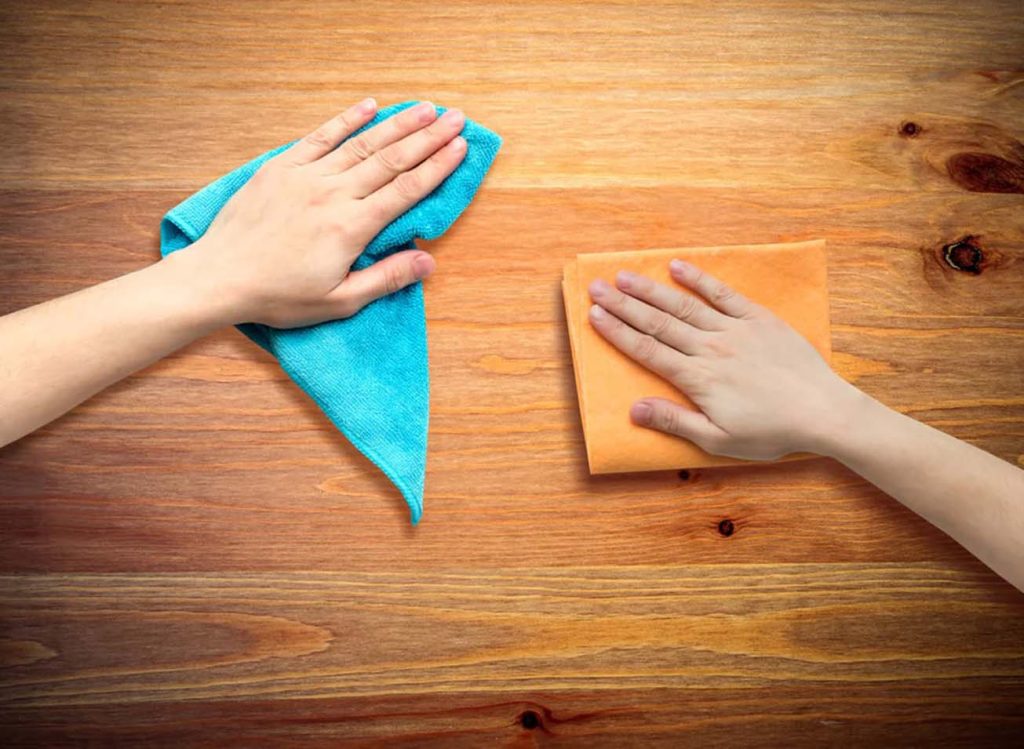
Maintaining the appearance and durability of your dining table requires regular cleaning and care. Here are some maintenance tips for different table materials:
- Solid Wood Tables: Regularly wipe with a clean, damp cloth and avoid chemical cleaners. Use specialized wood wax to maintain shine and durability. Avoid exposing solid wood tables to direct sunlight to prevent cracking and fading.
- Glass Tables: Use glass cleaner and a soft cloth to clean, avoiding scratches. Regular cleaning keeps the glass surface clear and smooth. Avoid placing heavy or sharp objects on the glass top to prevent scratches or breakage.
- Marble Tables: Avoid contact with acidic liquids like lemon juice and vinegar to prevent surface corrosion. Use specialized marble cleaners and periodically apply a sealant to protect against stains.
- Metal Tables: Regularly wipe with a dry cloth and avoid corrosive cleaners. Use protective coatings to prevent oxidation and rust. Avoid placing metal tables in humid environments to maintain their appearance and durability.
4.2 Matching Dining Tables with Chairs
The pairing of dining tables and chairs affects both comfort and aesthetics. Here are some pairing tips:
- Height Matching: The height of the dining table and chairs should be coordinated to ensure dining comfort. Generally, the table surface is 70-75 cm from the floor, and chair seat height is 45-50 cm. Choose ergonomically designed chairs for better support and comfort.
- Style Coordination: The style of the dining table and chairs should match to avoid visual conflict. You can choose chairs that match the table style or maintain consistency in design to achieve a harmonious look. For a classic table, choose similarly styled chairs; for a modern table, opt for minimalist chair designs.
- Comfort: Choose chairs with ergonomic designs to enhance dining comfort. Chair cushions and backs should offer appropriate softness and support for long meals. The chair design should also consider the table height to avoid uncomfortable seating.
5. Dining Table Trends
5.1 Use of Eco-Friendly Materials
With increasing environmental awareness, more dining tables are being made from sustainable materials such as reclaimed wood and eco-friendly composite boards. This not only helps protect the environment but also adds natural charm to the home. The use of eco-friendly materials reduces the consumption of natural resources and offers more green options for consumers.
5.2 Multi-Functional Designs
Modern dining tables increasingly emphasize multifunctionality, such as expandable tables and tables with storage features. These designs better adapt to different needs and space constraints. For example, expandable tables can adjust size as needed, and tables with storage provide extra space, ideal for small homes or multifunctional furniture needs.
5.3 Customizable Designs
Customizable dining tables are becoming a trend, allowing consumers to tailor materials, sizes, and styles to their preferences. Custom tables perfectly match home styles and meet personalized needs. Through customization, consumers can choose their preferred materials, colors, and designs to create unique dining tables, achieving personalized home styles.
Choosing a dining table that is both practical and stylish can significantly enhance the dining experience and overall aesthetics of the dining room. By considering the table’s size, material, shape, and brand recommendations, you can find the most suitable dining table for your home environment. Additionally, paying attention to table maintenance and trends ensures that your table remains attractive and functional for years.
